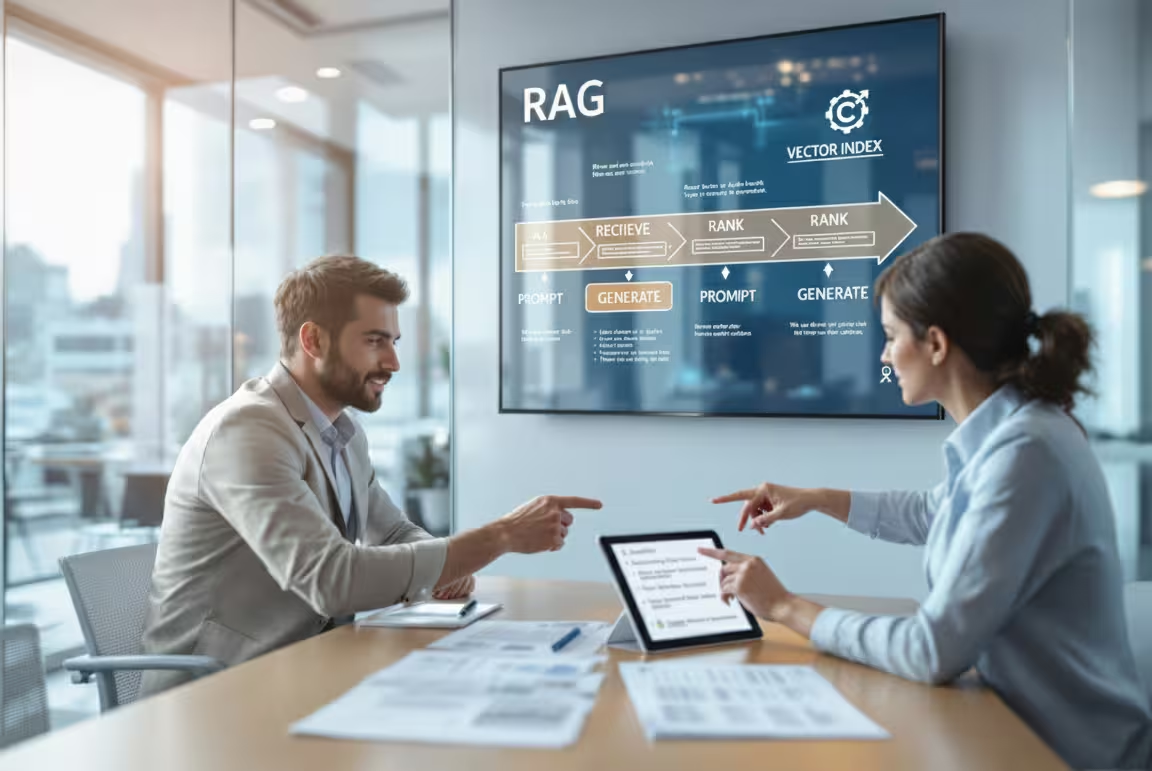What if AI could provide precise answers to business questions, based on your own internal documents? That's what RAG is all about: combining document research with the power of generative AI. The result: a knowledge engine that is integrated into your IS, scalable and under control. But to implement this successfully, it's not enough to simply pile on the technological building blocks. What are the key stages in a successful GAN project, the mistakes to avoid, and the skills to develop?

You've probably already been blown away by the power of a large language model (LLM) like ChatGPT. In just a few seconds, it can write an e-mail, summarise a long report or generate creative ideas. It works its magic... until you ask it a specific question about your profession or company.
Why do AIs disappoint you when it comes to your professional questions?
Do a little test. Confront a standard AI with a specific question such as: "What are the maternity leave entitlements in our company for a part-time contract? It will give you a generic answer, based on the Labour Code, completely ignoring the collective agreement or company agreement, which may grant additional days. In short, the answer is inaccurate, useless and even misleading. The model is disconnected from your reality.
This failure can be explained by the very design of LLMs, which suffer from a number of systemic flaws.
First and foremost, their knowledge is static, frozen at the date of their training. For example, ChatGPT 5, released in August 2025, responds from a knowledge base established in June 2024.
Secondly, and this is the crucial point, they know nothing about the specific context of your organisation. Without access to internal data, up-to-date procedures or specific conventions, these AIs generate generic or obsolete responses. What's more, they sometimes produce those famous "hallucinations" that are unacceptable for business expertise.
RAG in concrete terms: your AI becomes an in-house expert
So that LLMs finally become reliable and useful, they need to be contextualised and connected to your data.
The solution to this problem has a name: RAG, for Retrieval-Augmented Generation (generation increased by recovery).
This technology transforms a generalist AI into a true expert on your business. It is able to draw on your own documents to provide relevant, accurate and sourced answers.
Its major advantage lies in its speed and low cost of implementation, as it avoids a complete and costly re-learning of LLM.
How it works ?
There are two key stages in its operation:
- Recovery The system first indexes your documents (contracts, procedures, technical documentation, etc.) after breaking them down into small, relevant paragraphs (the " chunking" ). It then organises them in a vector database based on semantic similarity.
- Generation When a user asks a question, the RAG finds the most relevant extracts in this database and provides them to the LLM, who then writes an answer based explicitly on this information.
The RAG is a solution that is quick to implement and accessible to all sizes of company, even without an in-house AI team, especially via turnkey SaaS solutions.
How can you successfully integrate your data? Here are the essential steps.
The quality of AI depends first and foremost on your data
One of the most persistent preconceived ideas is that you need to inject as many documents as possible into a RAG system to make it more 'intelligent'. In reality, the opposite is true. The fundamental principle of 'garbage in, garbage out' applies perfectly here. A system fed by obsolete, redundant or contradictory documents can only generate confusing and unreliable answers.
Less is more
The best practice is to start with a restricted perimeter of very high quality. Concentrate first on your most reliable sources: official technical documentation, validated product sheets, articles in your knowledge base. Once the system has demonstrated its value on this controlled corpus, you can extend it cautiously.
The idea of simply "Dumping" thousands of documents into the system is doomed to failure. The preparation of data through stages such as segmentation (chunking) and vectorisation is a structured process, which involves cleaning up sources, removing duplicates, avoiding contradictory information and ensuring that documents are up to date, as Martina Machet from Société Générale points out.
Companies like Airbus and Safran have understood this. Their RAG projects focus on providing access to very specific technical documentation to assist operators, proving that the relevance and quality of the data far outweigh the volume.
To remember
Start with sanitising and labelling your critical content (HR policies, product guidelines, quality standards, etc.), then index them properly. LLM doesn't do magic: it uses what you give it.
Connect AI to your business tools with the MCP
Once your AI can tap into your documents, the next step is to connect it to your day-to-day applications and processes. To go beyond simple document retrieval and transform your AI into a truly proactive assistant, the Model Context Protocol (MCP) is establishing itself as a powerful, open standard.
He ensures seamless integration of AI with your data (databases, files, SharePoint, etc.), your business tools (CRM, ERP, tickets...) and your workflows (scripts, prompts).
Think of the MCP as the USB port for AI: a single connector on the server side, compatible with a multitude of AI assistants on the client side. Gone are the days when you had to develop a specific integration for each new platform!
The MCP is much more than a connector: it brings business context to AI
But the MCP does more than just connect data. Its real strength is its ability to transmit rich context to the model. It can inform the AI about the role of the user, their department, or the project they are working on. In this way, the AI no longer simply responds with reliable facts (thanks to the RAG), but does so by adopting the right business angle and respecting your internal processes.
The RAG + MCP combination is extremely powerfulbecause it transforms the AI of an assistant that answers to an agent who acts.
Let's take a advanced example. An operations manager asks : " Analyses the causes of the drop in performance on production line 7 this month and prepares a draft e-mail for the maintenance team with priority actions." The AI, via MCP, queries the ERP for production data, consults the maintenance system for current tickets (fed by RAG), and drafts a targeted action.
To remember
Le MCP makes life easier for tech teams: a single connector for connect your databases, files or business tools to several AIs (Claude, ChatGPT, Gemini, Mistral...). Result: fewer integrations to maintaina faster deployment. And, above all, responses that are much better adapted to the needs of your employees.
RAG is accessible to all organisations, even SMEs
Contrary to the popular belief that such innovations are the preserve of large groups, RAG technology is in fact very accessible.
The guide from the Direction Générale des Entreprises (DGE) says it in black and white: its adoption "does not require in-house AI or even IT skills", especially if you opt for turnkey SaaS solutions.
To get started, use tools such as NotebookLM or ChatGPT. They can be used to create a simple initial RAG with a handful of documents. For more structured requirements, dedicated SaaS platforms manage the entire process, from indexing to generating responses, with subscriptions tailored to smaller structures.
Companies looking for more control can turn to open source frameworks such as LangChain. This acts as a toolbox for developers. It allows them to assemble and customise each brick of the RAG system: connection to data sources, choice of vector base, orchestration of calls to the LLM, and so on. It's the royal road to a tailor-made project, without having to start from scratch.
To remember
Aim for a MVP (pilot project) in 6 to 10 weeks limited to a specific use case. This will enable you to prove the value of the RAG or AI before expanding deployment. Whether it's via a simple SaaS or an initial development with LangChain, give priority to demonstration by example A working prototype, satisfied users and tangible performance indicators.
| Objective | SaaS solutions (quick to deploy) | Open source tools (flexible and customisable) |
|---|---|---|
| Prototype a RAG in just a few hours |
NotebookLM (Google): simple, free, ideal for testing with a few documents. ChatGPT Enterprise/Business Integrated RAG via secure files and workspaces. |
LangChain + Chroma Perfect for quickly assembling a local RAG pipeline. |
| Connecting the RAG to Microsoft 365/SharePoint | Azure AI Search + Copilot native indexing of your M365 documents. | LlamaIndex ready connectors for SharePoint, OneDrive or SQL. |
| Industrialising a corporate RAG |
Mistral Le Chat Pro, Anthropic Claude for Business, Elastic AI Assistant European SaaS RAG, secure and configurable. Graphlit RAG-as-a-Service serverless, ingestion, multimodal. Progress Agentic RAG dedicated SaaS platform. |
Haystack (Deepset): complete framework for industrial RAG (OpenSearch, Pinecone, etc.). |
| Evaluating and improving responses | Copilot Studio or Vertex AI Search integrated tools for monitoring and adjusting performance. | Ragas, OpenDevin, TruLens to measure accuracy, hallucinations and the rate of anchoring in sources. |
| French/sovereign platforms |
ChapsVision RAG's "agentic AI" offer designed for your critical data and missions. LangSaaS French customisable chatbot platform powered by RAG. |
- |
RAG's greatest challenge is human, not technical
Adoption by the teams is the key to success. The success of a RAG project depends less on the choice of vector database than on the involvement of future users.
A technically perfect project can fail if it does not meet with the support of the teams. The DGE guide illustrates this risk. It cites the case of a major transport company faced with "acceptability issues". Its employees consider AI to be "uncertain" and prefer traditional methods.
To avoid this pitfall, involve end users at every key stage:
- Definedr use cases to ensure that the tool meets a real need
- Drawing up standard questions and answers to train and evaluate the system
- Participate in progress reviews to adjust development on an ongoing basis
- Providing feedback directly via the user interface for constant improvement
Training is also crucial to demystify the technology and emphasise that AI is intended to assist the professions in their tasks, and in no way to replace them.
To remember
Treat user experience (UX), there training and the change management as strategic topicsnot accessories.
The security of your data is the number 1 priority of any RAG project.
Connecting AI to your company's most strategic data makes security and governance absolutely non-negotiable. This is the foundation on which any RAG project must be built.
There is a major risk of confidential information leaking out. A local installation (on-premises) offers the best control. For its part, the cloud, with the use of services labelled SecNumCloud by ANSSI, is strongly recommended. Strict access controls (RBAC) must also be put in place. This ensures that each user only has access to authorised information. Finally, don't forget to comply with the European AI Act, which imposes transparency obligations from 2026.
To remember
Safety must be the the foundation of your project. Protect your sensitive data, strictly control access, choose trusted hosting and anticipate compliance.
Is your business ready for AI?
RAG technology marks a decisive step forward. It transforms LLMs from brilliant but disconnected generalists into true experts in your business.
But there's no magic formula for success. The key lies in the quality of your data, the involvement of your teams and solid governance.
And the technology doesn't stop there. Future developments towards autonomous and multimodal RAG agents promise to revolutionise not only access to information, but also the automation of complex business processes. AI is ready; the real question is whether your organisation is too.
The best ORSYS training courses on RAG
| Name of course | Opinion | Why is this interesting? | Testimonials |
|---|---|---|---|
| Developing your own intelligent agents (IAW) | 🟢 NEW | Training very practical on architectures RAG, GraphRAG and StructRAGideal for creating your own AI assistants connected to your internal documents. Allows you to experiment with generative AI applied to enterprise data. | "Very concrete: we leave with a working prototype. "Excellent balance between theory and practice. |
| State of the art of AI in the enterprise: from Machine Learning to generative AI (IAE) | ⭐ BEST | Excellent upgrade on the fundamentals of generative AI (LLM, ChatGPT, Copilot, diffusion models, etc.) and their practical applications in companies. | "A comprehensive and highly educational overview". "Ideal before launching an internal AI project. |
| Artificial intelligence security: issues, risks and best practice (SIA) | 🟢 NEW | Indispensable for understanding risks of data leakage, prompt injection attacks and best practices for securing models RAG/LLM. | "Indispensable for controlling AI risks. "Very concrete, full of real-life cases". |
| Innovating and transforming your business using data and AI (traditional or generative) (ITD) | 🟢 NEW | Link strategy, innovation and generative AI. Gives you the keys to aligning the IT Department and the business lines around a concrete AI vision (use cases, ROI, tools). | "Gives a clear vision of impactful AI use cases." "Very inspiring, practical and results-oriented." |




